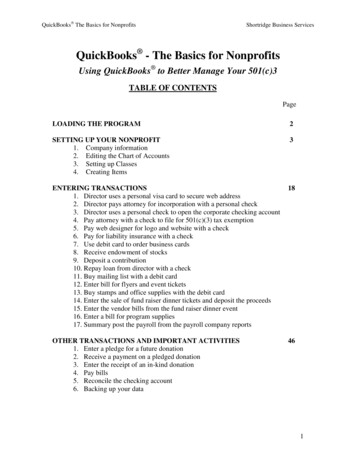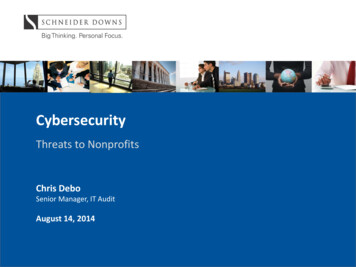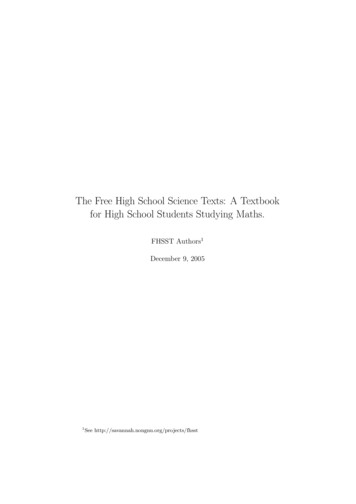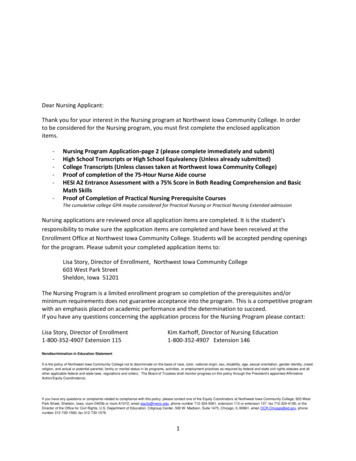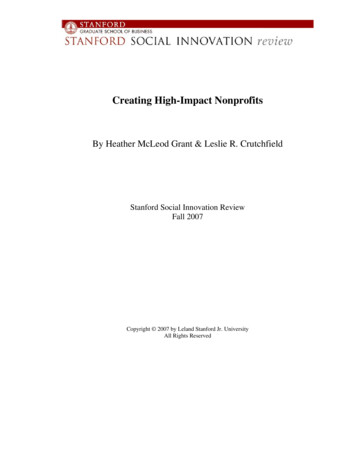
Transcription
Creating High-Impact NonprofitsBy Heather McLeod Grant & Leslie R. CrutchfieldStanford Social Innovation ReviewFall 2007Copyright 2007 by Leland Stanford Jr. UniversityAll Rights Reserved
CREATINGHIGH-IMPACTNONPROFITSConventional wisdom says that scaling social innovation starts with strengtheninginternal management capabilities. This study of 12 high-impact nonprofits,however, shows that real social change happens when organizations go outsidetheir own walls and find creative ways to enlist the help of others.b y H E AT H E R M C L E O D G R A N T & L E S L I E R . C R U T C H F I E L D32S TA N F O R D S O C I A L I N N O VAT I O N R E V I E W / f a l l 2 0 0 7www.ssireview.orgPHOTOGRAPHS BY MICHAEL BENSON PHOTOGRAPHY{ }IN FEWER THAN TWO DECADES, TEACH FOR AMERICAhas gone from a struggling start-up to a powerful force for education reform in the United States. Launched in 1989 by collegesenior Wendy Kopp on a shoestring budget in a borrowed office,the organization now attracts many of the country’s best andbrightest college graduates, who spend two years teaching inAmerica’s neediest public schools in exchange for a modest salary.In the last decade alone, Teach for America has more than quintupled in size, growing its budget from 10 million to 70 millionand its number of teachers from 500 to 4,400. And it aims to double in size again in the next few years.1But rapid growth is only part of New York-based Teach forAmerica’s story. Although its success can be measured by such tangibles as the number of teachers it places or the amount of moneyit raises, perhaps the organization’s most significant accomplishment is the movement for education reform it has created. Althoughsome education leaders are critical of the nonprofit’s teacher-train-
{This photograph of a boy wearing a Share Our Strength cap, and the other photographs that follow, were takenduring the Hinges of Hope Tour in the Rio Grande Valley. The February 2004 tour brought public and private sectorleaders to Texas to visit and learn about these impoverished communities. Share Our Strength, a high-impactnonprofit that combats childhood hunger in the United States, hosted the tour.}
ing program, and how long these teachers stay in the classroom,using such measures misses the larger, intangible impact theorganization has had. Teach for America has challenged howmany Americans think about teacher credentialing, shaken upthe education establishment, and, most important, created acommitted vanguard of education reformers.Teach for America has been so effective that it is now therecruiter of choice on many Ivy League campuses, often outcompeting elite firms like McKinsey & Company.2 Graduateswho went through the program in the 1990s are now launching charter schools, running for political office, managing foundations, and working as school principals across the country. Inthese capacities, they can effect change at the systemic level –not just child by child or classroom by classroom, but at theschool, district, and state levels.How has Teach for America accomplished so much in sucha relatively short period of time? And how have other similarlysuccessful nonprofits had such significant social impact? Ouranswers to this second question are the subject of this articleand the focus of our forthcoming book, Forces for Good: The SixPractices of High-Impact Nonprofits (Jossey-Bass, October 2007).We grounded our findings in several years of research on12 of the most successful nonprofits in recent U.S. history,including the well-known (Habitat for Humanity), the less wellknown (Self-Help), and the surprising (the Exploratorium).One nonprofit, Environmental Defense, has helped reduceacid rain in the northeastern United States and created new soluHEATHER MCLEOD GRANT is an adviser to the Center for theAdvancement of Social Entrepreneurship at Duke University’s FuquaSchool of Business and the Center for Social Innovation at Stanford University’s Graduate School of Business.LESLIE R. CRUTCHFIELD is managing director of the Ashoka GlobalAcademy and a research grantee of the Aspen Institute’s Nonprofit Sectorand Philanthropy Program. Their book, Forces for Good: The SixPractices of High-Impact Nonprofits, was a project of the Center forthe Advancement of Social Entrepreneurship and will be published byJossey-Bass in October 2007.34S TA N F O R D S O C I A L I N N O VAT I O N R E V I E W / f a l l 2 0 0 7}tions to global warming. Another, City Year, hashelped thousands of young people serve their country and changed how we think about volunteerism.Collectively, these high-impact nonprofits havepressed corporations to adopt sustainable businesspractices and mobilized citizens to act on such issuesas hunger, education reform, and the environment.(See p. 36 for names and descriptions of all 12 organizations.)What we discovered after closely examiningthese 12 high-impact nonprofits came as a bit of asurprise. We had assumed that there was something inherent in these organizations that helpedthem have great impact – and that their success was directly tiedto their growth or management approach. Instead, we learnedthat becoming a high-impact nonprofit is not just about building a great organization and then expanding it to reach morepeople. Rather, high-impact nonprofits work with and throughorganizations and individuals outside themselves to create moreimpact than they ever could have achieved alone. They buildsocial movements and fields; they transform business, government, other nonprofits, and individuals; and they changethe world around them.Myths of Nonprofit ManagementWe first examined the 12 organizations through the lens of traditional nonprofit management, studying their leadership, governance, strategies, programs, fundraising, and marketing. (Seep. 40 for details on how we selected and studied these nonprofits.)We thought we would find that their success was due to timetested management habits like brilliant marketing, well-tunedoperations, or rigorously developed strategic plans.But instead what we found flew in the face of conventionalwisdom. Achieving high impact is not just about building a greatorganization and then scaling it up site by site, or dollar by dollar. As we got further into our research, we saw that many commonly held beliefs about what makes nonprofits successfulwere falling by the wayside. In fact, the vast majority of nonprofit literature focuses on issues that, although important,don’t determine whether an organization has impact, such as:Myth #1: Perfect Management. Some of the organizations we studied are not exemplary models of generally acceptedmanagement principles. Although adequate management isnecessary, it is not sufficient for creating significant social impact.Myth #2: Brand-Name Awareness. A handful of groupswe studied are household names, but a few hardly focus on marketing at all. For some, traditional mass marketing is a criticalpart of their impact strategy; for others, it’s unimportant.www.ssireview.org
Myth #3: A Breakthrough New Idea. Although somegroups come up with radical innovations, others take old ideasand tweak them until they achieve success.Myth #4: Textbook Mission Statements. All of thesenonprofits look to compelling missions, visions, and sharedvalues. But only a few of these groups spend time fine-tuningtheir mission statement on paper; most of them are too busyliving it.Myth #5: High Ratings on Conventional Metrics. Whenwe looked at traditional measures of nonprofit efficiency, manyof these groups didn’t score well, because they don’t adhere tomisleading metrics such as overhead ratios.Myth #6: Large Budgets. We discovered that size doesn’t correlate with impact. Some of these nonprofits have madea big impact with large budgets; others have achieved similarimpact with much smaller budgets.As we dismissed the conventional wisdom about whatmakes high-impact nonprofits successful, we realized we haddiscovered a new way of understanding this sector – and whatenables the best nonprofits to create lasting social change.3Six Practices of High-Impact NonprofitsThe secret to their success lies in how high-impact nonprofitsmobilize every sector of society – government, business, nonprofits, and the public – to be a force for good. In other words,greatness has more to do with how nonprofits work outside theboundaries of their organizations than with how they managetheir own internal operations. The high-impact nonprofits westudied are satisfied with building a “good enough” organization and then focusing their energy externally to catalyze largescale change.To paraphrase Archimedes, “Give me a lever long enoughand I alone can move the world.” These groups use the powerof leverage to create change. In physics, leverage is defined asthe mechanical advantage gained from using a lever. In business,it means using a proportionately small initial investment togain a high return. The concept of leverage captures exactly whathigh-impact nonprofits do. Like a man lifting a boulder threetimes his weight with a lever and fulcrum, these nonprofits areable to achieve greater social change than their mere size or structure would suggest.After a long process of studying these 12 nonprofits, webegan to see patterns in the ways they work. In the end, six patterns crystallized into the form presented here – the six practicesthat high-impact nonprofits use to achieve extraordinary impact:1. Serve and Advocate: High-impact organizations maywww.ssireview.orgstart out providing great programs, but they eventually realizethat they cannot achieve large-scale social change through service delivery alone. So they add policy advocacy to acquiregovernment resources and to change legislation. Other nonprofits start out by doing advocacy and later add grassroots programs to supercharge their strategy.Ultimately, all high-impact organizations bridge the dividebetween service and advocacy. They become good at both.And the more they serve and advocate, the more they achieveimpact. A nonprofit’s grassroots work helps inform its policyadvocacy, making legislation more relevant. And advocacy at thenational level can help a nonprofit replicate its model, gaincredibility, and acquire funding for expansion.4The nonprofit Self-Help, based in Durham, N.C., presentsan excellent example of how combining advocacy with servicecan result in greater impact. Self-Help began by giving homeloans to clients – often poor, minority single mothers – whodid not qualify for traditional mortgages. Although its serviceshelped thousands of low-income families purchase a house,Self-Help’s work was soon undermined by predatory lenders,which took advantage of vulnerable borrowers by addingexcessive fees or charging exorbitant mortgage rates, virtuallyensuring that the borrower would default.Eventually, Self-Help organized a statewide coalition inNorth Carolina and lobbied to pass the first anti-predatory lending law in the country. Later, the organization established thesubsidiary Center for Self-Help to help local nonprofits passsimilar legislation in 22 additional states. Through its direct services, Self-Help has given more than 4.5 billion in homeloans to low-income families in the United States. But throughits advocacy efforts, it has created far more value for the country’s most vulnerable populations by protecting them frompredatory lenders.In nearly every case we studied, the nonprofit combineddirect service programs and advocacy to enhance its impactover time. Some groups, like America’s Second Harvest andHabitat for Humanity, began by providing services, such asfeeding the hungry or housing the poor, and added advocacyonly after a decade or more. Other groups, like the Center onBudget and Policy Priorities, the Heritage Foundation, andEnvironmental Defense, began with advocacy and later addedgrassroots programs or services to expand their impact tothe local and state level. Some groups, like City Year and theNational Council of La Raza, did both from the outset, despitepressure to specialize, and recognized early that advocacy andservice reinforce each other.2. Make Markets Work: High-impact nonprofits havelearned that tapping into the power of self-interest and the lawsof economics is far more effective than appealing to pure altruism. No longer content to rely on traditional notions of charity,f a l l 2 0 0 7 / S TA N F O R D S O C I A L I N N O VAT I O N R E V I E W35
TWELVE HIGH-IMPACT NONPROFITSOrganizationRevenueYear founded,headquartersFiscal year ’05( millions)America’s Second Harvest1979, Chicago543*How the organization worksWhat the organization has accomplishedDistributes donated food and groceryproducts to grassroots nonprofits;advocates for antihunger policyDistributed 2 billion pounds of food each yearthrough more than 200 food banks to morethan 50,000 local nonprofits, feeding 25 millionhungry AmericansCenter on Budget andPolicy Priorities1981, Washington, D.C.13Researches and analyzes state andfederal budgets and fiscal policies;advocates on behalf of the poorProtected billions of dollars in federal benefitsand allocations to programs for the poor byworking with 26 state affiliates and 6,000 localnonprofits; established state and internationalbudget projectsCity Year1988, Boston42Builds democracy through citizenservice, leadership, and socialentrepreneurship; advocates fornational service policyCreated youth volunteer service corps thatoperates in 17 U.S. cities and South Africa, with8,000 alumni; influenced adoption of AmeriCorps,which enlists 70,000 volunteers annually;helped build fields of youth service and socialentrepreneurshipEnvironmental Defense1967, New York69Addresses environmental problemswith research, advocacy, market tools,and corporate partnershipsInfluenced critical environmental policies,including Clean Air Act and Kyoto Protocol;helped companies like McDonald’s, FedEx, andWal-Mart Stores become more environmentallysustainableThe Exploratorium1969, San Francisco44Operates museum of science, art, andhuman perception that is a model fornew forms of educationInfluenced global movement for interactivescience centers and museums, reaching 20million people through exhibits at 124 partnermuseums and a Web site; museum attracts500,000 visitors each year1,000*Seeks to eliminate poverty housingand homelessness by building homes,raising awareness, and advocatingfor changeCreated 2,100 global affiliates in 100 countriesand built 275,000 homes, which now house1 million peopleThe Heritage Foundation1973, Washington, D.C.40Formulates and promotes conservativepolicy through research and bycreating affiliate organizationsCrafted policy agenda for the Reagan administration; helped lead conservative revolutionin Congress in 1990s; now works with 2,500state affiliates and 200,000 individual membersNational Council ofLa Raza1968, Washington, D.C.29Works to improve opportunities forall Latinos through national networkof affiliated civil rights and advocacyorganizationsHelped create more than 300 local grassrootsaffiliates that are involved in education, health,and civil rights for Hispanics; influenced criticallegislation on immigrationSelf-Help1980, Durham, N.C.75Fosters economic development in lowincome communities through lending,asset building, research, and advocacyCreated corporate partnerships that allowed itto provide more than 4.5 billion in loans to50,000 small businesses and low-income people;led national anti-predatory lending campaignand legal reform in 22 statesShare Our Strength1984, Washington, D.C.24Inspires and leads individuals andbusinesses to end childhood hungerRaised 200 million for hunger-relief groupsthrough events in 60 cities; involved 1 millionvolunteers in the Great American Bake SaleTeach for America1990, New York41Recruits recent college graduates tospend two years teaching in needyschools and to lead education reformTrained 12,000 college graduates to teach2.5 million students, creating a vanguard foreducation reform; influenced teacher trainingand credentialing practicesYouthBuild USA1988, Boston18Helps low-income youths learn job andleadership skills by building affordablecommunity housingRecruited more than 60,000 youths and 226affiliates to help build 15,000 units of housing;influenced national legislation to create 645million in federal fundingHabitat for HumanityInternational1976, Americus, Ga.* Budget includes value of in-kind donations36S TA N F O R D S O C I A L I N N O VAT I O N R E V I E W / f a l l 2 0 0 7www.ssireview.org
{ }or to see business as an enemy,these nonprofits find ways towork with markets and helpcompanies “do good while doingwell.” They influence businesspractices, build corporate partnerships, and develop earnedincome ventures to achieve socialchange on a grander scale.5Environmental Defense wasone of the first nonprofits torealize the power of harnessingmarket forces for social change.The New York-based organization was founded in the late1960s by a group of scientistswho lobbied to ban the use ofDDT, and its informal motto foryears was “sue the bastards.”Over time, however, the nonprofit became known for a different – and initially more radical – approach: working with corporations to change theirbusiness processes and become more sustainable.For example, even though other green groups criticizedEnvironmental Defense for “selling out” at the time, the nonprofit worked with McDonald’s in the 1980s to make the fastfood giant’s packaging more environmentally sound. Sincethen, Environmental Defense has worked with hundreds ofcompanies – from FedEx to Wal-Mart Stores – often scalingits innovations to change practices in an entire industry.Although these partnerships are becoming more commonamong environmental groups, Environmental Defense was anearly pioneer in this area.But Environmental Defense didn’t just set out to change businesses’ behavior. It went a step further, harnessing marketforces to help solve larger environmental problems. Environmental Defense has been a strong proponent of market-basedsystems to control pollution, such as “cap and trade,” whichestablishes overall emission limits (on carbon, for example),and then creates economic incentives for companies to complyand reduce their emissions. Cap and trade systems helpedreduce acid rain in the northeast United States and have becomean important tool in the effort to fight global warming. In fact,this approach led to the passage of California’s Global Warming Solutions Act of 2006, the first statewide legislation of itskind and a model for more stringent federal emissions controls.We found three primary ways in which high-impact nonprofits use markets. They help change business behavior on alarge scale, as did Environmental Defense. Self-Help also followedthis path, creating a secondary loan market and expanding itswww.ssireview.orginnovative lending modelsthrough mainstream financialplayers such as Wachovia andFannie Mae, thereby changingthe industry’s practices and helping large companies reach historically underserved markets.Nonprofits also leveragemarkets by partnering with corporations to garner additionalresources for their cause, as haveAmerica’s Second Harvest, CityYear, and Habitat for Humanity.All three have established largecorporate partnerships throughwhich they obtain funding,media relations, marketing support, and in-kind donations.Some nonprofits run theirown small businesses, generating income that helps fund theirprograms. Share Our Strength,for instance, runs a nonprofit consulting business called Community Wealth Ventures, whose revenue it redeploys towardits social mission.3. Inspire Evangelists: High-impact nonprofits buildstrong communities of supporters who help them achieve theirlarger goals. They value volunteers, donors, and advisers not onlyfor their time, money, and guidance, but also for their evangelism. To inspire supporters’ commitment, these nonprofits create emotional exp
Myths of Nonprofit Management We first examined the 12 organizations through the lens of tra-ditional nonprofit management, studying their leadership
